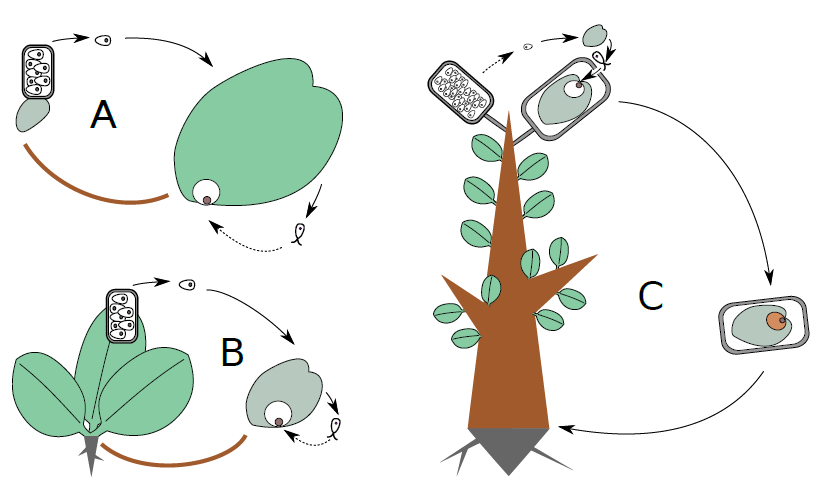3.12.3: Three phyla of plants
- Page ID
- 49976
As animal phyla differ by body plans, plant phyla differ with life cycles. Plants started from green algal ancestors which have no diplont, only zygote was diploid in their life cycle. But diplont is better! So plants gradually increased the diploid stage (plant’s diplont is called sporophyte) and reduced haploid (gametophyte). And they still did not reach the animal (gametic) shortcut of the life cycle, even in most advanced plants there is small gametophyte of few cells. One of reasons is that plants do not move, and young sporophyte always starts its life on the mother gametophyte.
Mosses have sporophyte which is adapted only for spore dispersal. Gametophyte is then a main photosynthetic stage which makes most of photosynthesis and therefore need to be big. However, it cannot grow big! This is because for the fertilization, it needs water. Therefore, mosses could not be larger then the maximal level of water.
To overcome the restriction, stages role must reverse. Ferns did that, and their gametophyte is really small and adapted only for fertilization. This works pretty well but only if the plant body is relatively small.
Trees capable to secondary growth (that is, thickening of stem with special “stem cells”) will experience the ecological conflict between ephemeral, minuscule gametophyte and giant stable sporophyte. Whatever efforts sporophyte employs, result is unpredictable. Birth control, so needed for large organisms, is impossible. One solution is not to grow so big.
Another solution is much more complicated. They need to reduce gametophyte even more and place it on sporophyte. And also invent the new way of bringing males to female because between tree crowns, the old-fashioned water fertilization is obviously not possible. To make this new way (it called pollination), some other external agents must be employed. First was a wind, and the second came out of the clever trick to convert enemies into friends: insects.
Still, result was really cumbersome and the whole life cycle became much slower than in ferns, it could span years! The only way was to optimize and optimize it, until in flowering plants, it starts to be comparable and even faster then in two other phyla.


